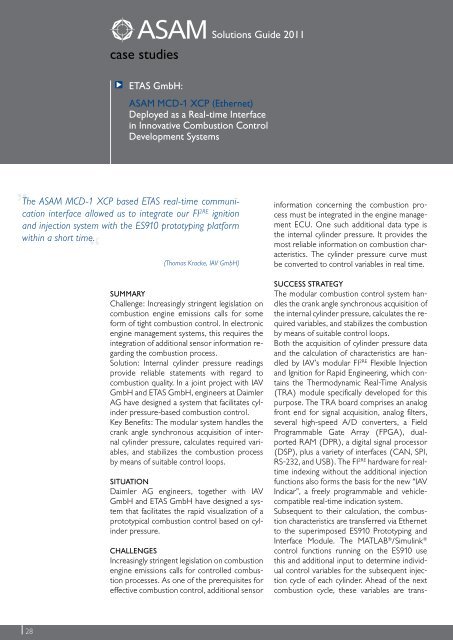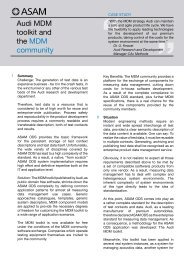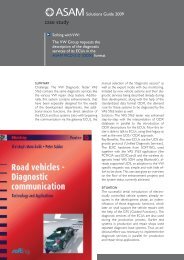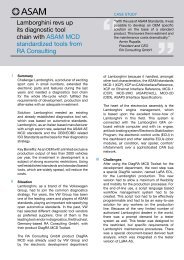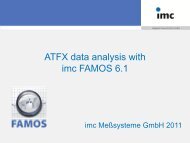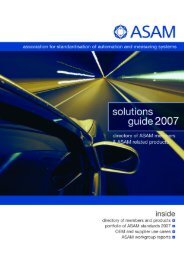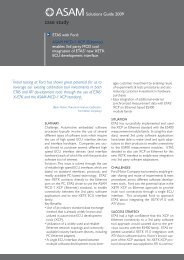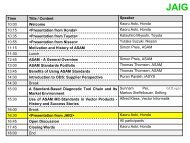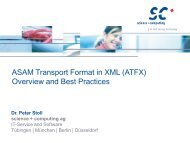Download now - ASAM
Download now - ASAM
Download now - ASAM
- TAGS
- download
- asam
- www.asam.net
Create successful ePaper yourself
Turn your PDF publications into a flip-book with our unique Google optimized e-Paper software.
28<br />
case studies<br />
etaS gmbh:<br />
Solutions Guide 2011<br />
aSam mCD-1 XCP (ethernet)<br />
Deployed as a real-time interface<br />
in innovative Combustion Control<br />
Development Systems<br />
The <strong>ASAM</strong> MCD-1 XCP based ETAS real-time communication<br />
interface allowed us to integrate our FI 2RE ignition<br />
and injection system with the ES910 prototyping platform<br />
within a short time.<br />
(Thomas Kracke, IAV GmbH)<br />
Summary<br />
Challenge: Increasingly stringent legislation on<br />
combustion engine emissions calls for some<br />
form of tight combustion control. In electronic<br />
engine management systems, this requires the<br />
integration of additional sensor information regarding<br />
the combustion process.<br />
Solution: Internal cylinder pressure readings<br />
provide reliable statements with regard to<br />
combustion quality. In a joint project with IAV<br />
GmbH and ETAS GmbH, engineers at Daimler<br />
AG have designed a system that facilitates cylinder<br />
pressure-based combustion control.<br />
Key Benefits: The modular system handles the<br />
crank angle synchronous acquisition of internal<br />
cylinder pressure, calculates required variables,<br />
and stabilizes the combustion process<br />
by means of suitable control loops.<br />
Situation<br />
Daimler AG engineers, together with IAV<br />
GmbH and ETAS GmbH have designed a system<br />
that facilitates the rapid visualization of a<br />
prototypical combustion control based on cylinder<br />
pressure.<br />
ChallengeS<br />
Increasingly stringent legislation on combustion<br />
engine emissions calls for controlled combustion<br />
processes. As one of the prerequisites for<br />
effective combustion control, additional sensor<br />
information concerning the combustion process<br />
must be integrated in the engine management<br />
ECU. One such additional data type is<br />
the internal cylinder pressure. It provides the<br />
most reliable information on combustion characteristics.<br />
The cylinder pressure curve must<br />
be converted to control variables in real time.<br />
SuCCeSS Strategy<br />
The modular combustion control system handles<br />
the crank angle synchronous acquisition of<br />
the internal cylinder pressure, calculates the required<br />
variables, and stabilizes the combustion<br />
by means of suitable control loops.<br />
Both the acquisition of cylinder pressure data<br />
and the calculation of characteristics are handled<br />
by IAV’s modular FI 2RE Flexible Injection<br />
and Ignition for Rapid Engineering, which contains<br />
the Thermodynamic Real-Time Analysis<br />
(TRA) module specifically developed for this<br />
purpose. The TRA board comprises an analog<br />
front end for signal acquisition, analog filters,<br />
several high-speed A/D converters, a Field<br />
Programmable Gate Array (FPGA), dualported<br />
RAM (DPR), a digital signal processor<br />
(DSP), plus a variety of interfaces (CAN, SPI,<br />
RS-232, and USB). The FI 2RE hardware for realtime<br />
indexing without the additional injection<br />
functions also forms the basis for the new “IAV<br />
Indicar”, a freely programmable and vehiclecompatible<br />
real-time indication system.<br />
Subsequent to their calculation, the combustion<br />
characteristics are transferred via Ethernet<br />
to the superimposed ES910 Prototyping and<br />
Interface Module. The MATLAB ® /Simulink ®<br />
control functions running on the ES910 use<br />
this and additional input to determine individual<br />
control variables for the subsequent injection<br />
cycle of each cylinder. Ahead of the next<br />
combustion cycle, these variables are trans-


